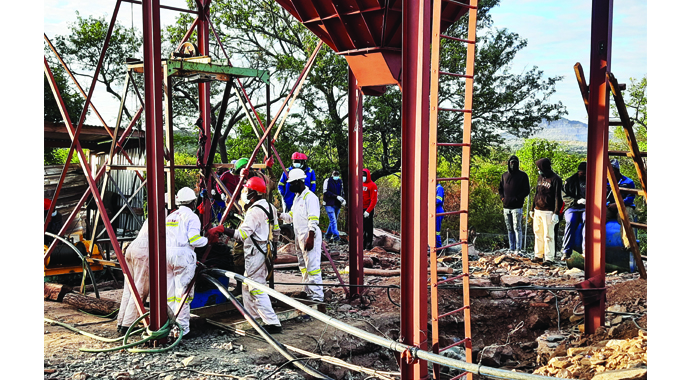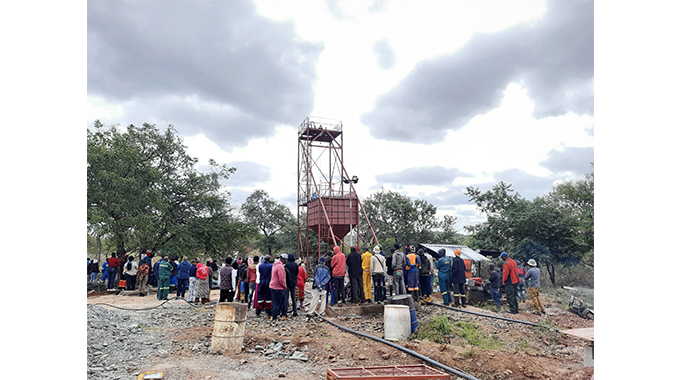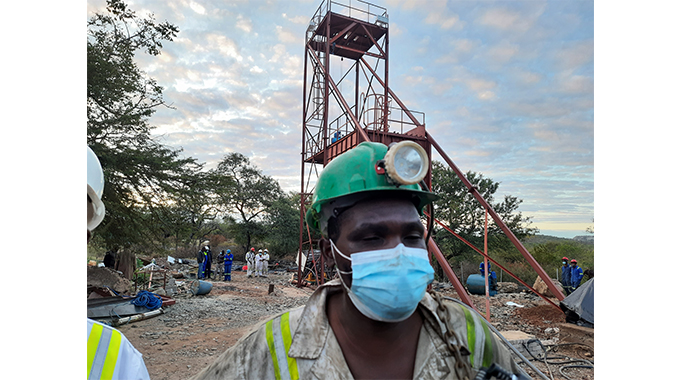The Chronicle

Yoliswa Dube-Moyo, Matabeleland South Bureau Chief
AFTER struggling to navigate the slippery, meandering dirt road to Bucks Mine in Colleen Bawn on Monday following news that seven miners had plunged down a 240-metre-deep shaft after hoisting ropes to a skip bringing them up the shaft had snapped, I expected no trouble upon my arrival.
The lives of seven men were in danger and at this point, hope was still alive that they could survive the accident.
Rescuers kept going in and out of the shaft as they frantically tried to save the miners while family members watched helplessly. Some gathered around small fires, barely talking to each other.
 File picture: Rescue workers retrieve bodies of the trapped miners at Bucks Mine in Colleen Bawn this week
File picture: Rescue workers retrieve bodies of the trapped miners at Bucks Mine in Colleen Bawn this weekI watched and waited with them. Rescuers had to first repair pipes and a pump in the mine before they could start pumping out water from underground in order to locate the trapped miners.
I later learnt that in addition to repairing the broken pipes, rescuers also had to install working platforms and clean the shaft before they could start retrieving the bodies.
It took a bit of a while and it was easy to tell that the environment had grown volatile. Everyone was anxious.
Family members had sketchy details of what the rescue mission entailed and the mine owners were generally not forthcoming with information.
The mine owners had managed to control who went in and out of the mine on Saturday and Sunday but by Monday, the cat was out of the bag.
Tragedy had struck and the nation needed to be informed.
On Tuesday rescuers reported that they had started to see bodies floating on water. This was after three days of continuously pumping water out of the mine.
 Dejected relatives watch as more bodies are brought to the surface
Dejected relatives watch as more bodies are brought to the surfaceThe wait was finally over but what followed was harrowing as rescuers started pulling out bodies from the shaft.
The smell of death still has not left me. The lewd smell of decomposing bodies that had invited flies to hover all over still lingers.
In my quiet moments, I still see men struggling to straighten whitish limbs of corpses that had been under water for more than 72 hours. Some of the retrieved bodies had skin peeling off due to prolonged exposure to water.
The other bodies had been badly injured with their heads crushed, which made it difficult for co-workers to identify the deceased miners.
Rescuers tussled to extend the legs, fold the arms, place the hands on top of the chest, adjust the head to face forward and eventually lay a blanket over the deceased.
The bodies lay next to the shaft for hours before police officers decided to move them to a mortuary, two at a time.
This meant we had to spend the whole day with the dead among us. Family members who had identified the deceased were beside themselves as they had no option but to wait for the police before the bodies could be handed over to them. It was torture.
“We’re from Hwange and before we decided to come here, the owners kept telling us everything was under control. But I had a bad feeling about everything and decided to come despite them trying to allay my fears. When we arrived, we were just told to wait and not interfere. We spent the whole of Sunday and Monday at the mine waiting for news. We slept in cars because we were anxious to stay in the loop of what was happening,” said Ms Karen Nare, an aunt to one of the deceased.
She expressed her anger towards the owners of the mine whom she said mistreated distressed family members.
“Even after we had identified my nephew’s body, we struggled to get his belongings that included blankets, clothes and a cellphone. I had last spoken to my nephew on Saturday morning and the next thing I heard there had been an accident. The wound will take a long while to heal,” said Ms Nare.
 Bucks Mine in Colleen Bawn
Bucks Mine in Colleen BawnIn an interview after five bodies had been retrieved from the shaft, Vubachikwe Mine rescue team captain Mr Cleopas Karima said the rescue mission had been a difficult one.
“We started pumping water on Sunday around 10PM because the mine had problems with broken pipes so we started by equipping the pipes and the pump. We continued pumping until Monday around 10PM, that’s when we started to see the first body floating on top of water. We continued pumping until today (Tuesday) around 5AM, that’s when we saw six bodies,” said Mr Karima.
He said the team started cleaning the shaft and installing some working platforms to enable them to retrieve the bodies.
“We started retrieving the bodies around 9AM today (Tuesday) but still our challenge is that there’s still water underground. The water from the expected platform is about three meters which makes it difficult for us,” said Mr Karima.
Preliminary investigations indicate that the equipment that was in use at the mine had not been certified by the Government inspectorate.
Before any mine in the country begins operations, all moving and non-moving equipment should be inspected and certified by the chief Government mining engineer before it is commissioned.
Earlier, the Chief Government Mining Engineer Mr Michael Munodawafa told Chronicle the cocopone that plunged had seven miners but it was supposed to carry four people.
 Rescue team captain Mr Cleopas Karima
Rescue team captain Mr Cleopas KarimaHe said the rope had not been approved by the Ministry of Mines and Mining Development inspectorate.
“Investigations are still ongoing but one of the major issues is the non-commissioning of the equipment at the mine. Any moving and non-moving equipment should be commissioned. Even the shaft itself should be commissioned. We’re supposed to come and inspect as well as certify the equipment.
Once it’s certified, it means the problem has moved from the mine owner to the regulating authority. We’ve found out that an eight-millimeter wire rope was used, which was not enough to hold a one tonne cocopone. The rope should’ve been at least 13 millimeters and above. Also, a cocopone takes four people but they put seven.
The rope itself is supposed to be commissioned by the Ministry of Mines and Mining Development inspectorate but not even our Gwanda or Harare offices have any documentation pertaining to the commissioning unless the mine owners can prove otherwise. We keep a copy in Gwanda, another in Harare and one for the miners,” said Mr Munodawafa.
– @Yolisswa
Article Source: The Chronicle
